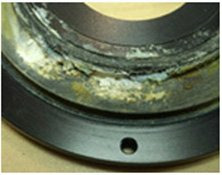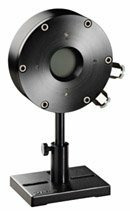| Sensor |
Recommended flow rate at full power1 |
Minimum flow rate at full power1 |
Absolute minimum flow rate |
Pressure drop across sensor (at maximum flow rate) |
pressure drop across 8 meter of tubing (at maximum flow rate) |
| L250W |
3 l/m |
3 l/m |
3 l/m |
0.3 Bar (0,03 MPa) |
|
| L300W |
3 l/m |
3 l/m |
3 l/m |
0.3 Bar (0,03 MPa) |
|
| 1000W |
6 l/m |
3 l/m |
3 l/m |
0.3 Bar (0,03 MPa) |
0.5 Bar (0,05 MPa) |
| L1500W |
6 l/m |
3.5 l/m |
3 l/m |
0.3 Bar (0,03 MPa) |
0.5 Bar (0,05 MPa) |
| L2000W |
6 l/m |
3.5 l/m |
3 l/m |
0.6 Bar (0,06 MPa) |
0.5 Bar (0,05 MPa) |
| 5000W |
8 l/m |
5 l/m |
3 l/m |
0.6 Bar (0,06 MPa) |
0.5 Bar (0,05 MPa) |
| 6K-W-200x200 |
6 l/m |
6 l/m |
5 l/m |
0.5 Bar (0,05 MPa) |
0.3 Bar (0,03 MPa) |
| 10K-W |
8 l/m |
8 l/m |
3 l/m |
1 Bar (0,1 MPa) |
0.5 Bar (0,05 MPa) |
| 15K-W |
12 l/m |
12 l/m |
3 l/m |
2 Bar (0,2 MPa) |
1 Bar (0,1 MPa)0.5 Bar |
| 16K-W |
12 l/m |
12 l/m |
3 l/m |
1 Bar (0,1 MPa) |
0.8 Bar (0,08 MPa) |
| 30K-W |
25 l/m |
25 l/m |
6 l/m |
2 Bar (0,2 MPa) |
3 Bar (0,3 MPa) |
| 120K-W |
60 l/m |
60 l/m |
30 l/m |
4 Bar (0,4 MPa) |
3.5 Bar (0,35 MPa) |
¹ Proportionally lower flow rate at lower power subject to absolute minimum
What flow rate do we need if the sensor is not running at full power? In principle, the water flow rate would then be proportionally less, i.e. if the power is ½, then the flow rate is ½ of the value in the table above. However, the sensor will not operate properly if the flow rate is too low so the flow rate should be within the limits of the table above.
What about the water inlet temperature? We usually specify that the water inlet temperature should be between 15degC and 30degC. The reason for not using a lower temperature is that this may result in water condensation on the absorber surface. If this is not a problem, then the minimum water temperature can be even colder than 15degC. However, note that there may be an offset of the zero where the cold sensor seeing the warmer room will register a positive reading even without any laser input. This can be offset in the user software.
What about the water temperature stability? The sensor measures the heat flow across the thermopile disc inside. If the water temperature changes suddenly, this will affect the heat flow and therefore also the power reading. Therefore, we specify that the water temperature should not change by more than 1degC/min. The reading of the power sensor may also be affected by sudden fluctuations in the water flow rate so those should also be eliminated. See below.
Requirements on the water cooling system: Ophir does not supply cooling and water flow equipment for the sensor but the chiller used should be able to maintain the specified water temperature and flow rate at maximum heat load, e.g. if you plan to use the sensor at 10kW, then the chiller should be able to maintain a temperature in the permitted temperature range at that power. In addition, the chiller should be able to maintain a constant temperature without large sudden fluctuations in temperature as stated above. Sometimes, the cooling water is daisy chained where it goes through several devices including the power meter in the same loop. In that case, care should be taken that the power meter is not immediately downstream from a device that is alternately putting heat in and not thus causing fluctuations in the water temperature. If the cooling system nonetheless is configured so that there are sudden changes in temperature from the chiller turning on and off or previous devices and this affects the reading, this may be lessened by putting a mixing water tank (>30 liter) between the chiller and the sensor to even out the temperature.
Does the water flow need to be on at all times, even at low powers? First of all, the water flow should be on for some time before starting measurement. The sensor takes time, up to 1 min, to stabilize after the water flow is started. As for use at low powers, water cooled sensors will not work properly at all unless the sensor is filled with water to make thermal contact between the disc and sensor. If the sensor is filled with water and the input and output connectors are stopped up, then the sensor can be used for a short time without water flow or at much reduced power continuously. Note, however, that when used this way, the response time of the sensor may not be optimal and it may be slow or overshoot.
Corrosion is the gradual destruction of materials (usually metals) by chemical reaction with their environment. Metals are converted to a more stable form such as their oxides, hydroxides, or sulfides (Wikipedia).
Corrosion is caused by interactions between the metallic components of the sensor and the cooling water, which may contain a variety of dissolved ions. Many factors affect the risk of corrosion forming, but the most important are the pH and the mixture of ions in the water.
Most Ophir water cooled sensors have a hard anodized housing and in rare cases depending on the water composition, the housing can corrode. (see fig. 1) This usually begins at a crack in the anodize coating of the housing exposing the bare aluminum. Cracks can develop a local chemistry, resulting in localized acidity and concentrations of non-volatile impurities, that greatly accelerates corrosion.



 Ultra-High Velocity
Ultra-High Velocity